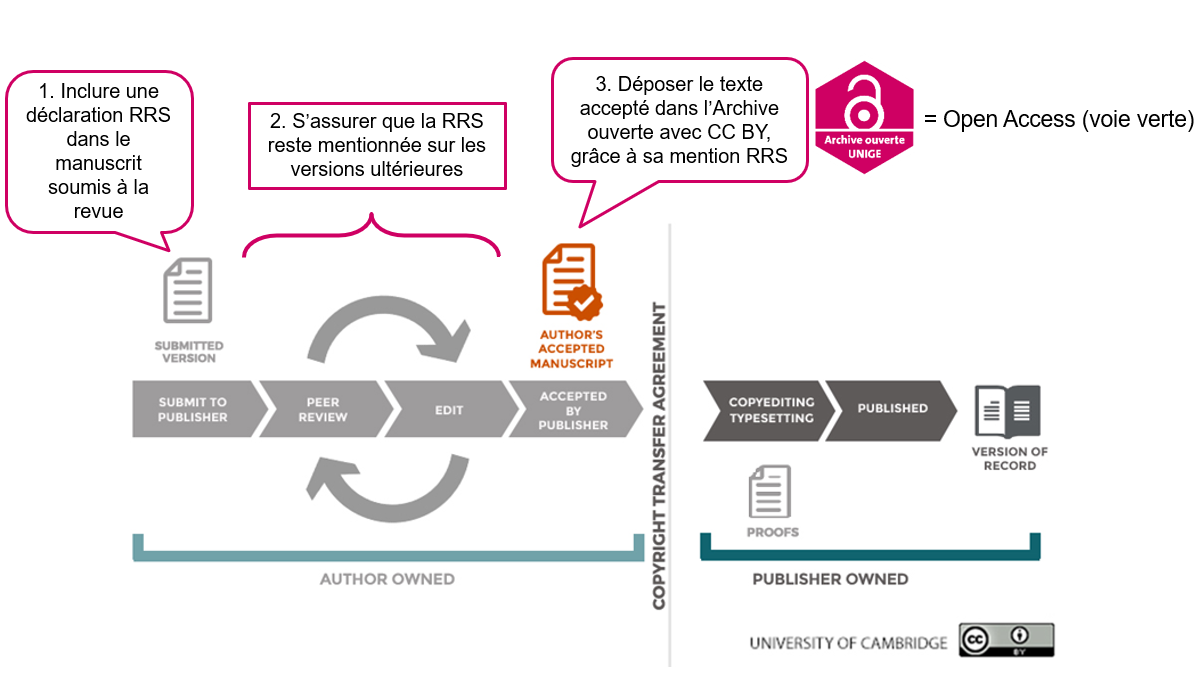Rights Retention Strategy (RRS)
Background
The Rights Retention Strategy (RRS) is promoted by cOAlition S members to allow the researchers they fund to disseminate freely their publications while remaining fully compliant with the requirements of Plan S.
The Swiss National Science Foundation (SNSF) has joined cOAlition S in 2022. All publications from projects submitted after January 1, 2023 must be in Open Access without embargo and licensed under a CC BY license (12 months of embargo are accepted for books). The Rights Retention Strategy is a mechanism to meet these requirements.
how does it work?
This strategy uses the green road of Open Access.
The author makes their obligations to the funder known as soon as the manuscript of the article is submitted by adding a statement to it, for example on the first page or in the acknowledgement section. The following statement can be used by SNSF-funded individuals:
„This research was funded in whole or in part by the Swiss National Science Foundation (SNSF) [Grant number]. For the purpose of Open Access, a CC BY public copyright licence is applied to any Author Accepted Manuscript (AAM) version arising from this submission.”
This statement must appear on all versions of the article, from the submitted version to the Author Accepted Manuscript (AAM).
The strategy is based on the principle that the accepted version, after peer review, is the intellectual creation of the author and belongs to them. Applying a CC BY license to this document allows the author to claim ownership and retain their rights to distribute it freely. Thus, even if the author later transfers their rights to a third party (for example to the publisher), they remain entitled, like anyone else, to benefit from the permissive conditions of the CC BY license. The author can therefore reuse the text of their work as they wishes.

[Image credits: Claire Sewell & University of Cambridge. https://www.slideshare.net/ClaireSewell/open-access-webinar, slide 16, August 2017. Licensed under CC BY https://creativecommons.org/licenses/by/4.0/deed.fr. Adaptations: Floriane Muller + Dimitri Donzé, UNIGE Library. The original schema has been rearranged (removal and moving of icons). The elements in pink have been added as well as the text they contain].
At the latest when the article is published, the accepted version (AAM) must be deposited in Archive ouverte UNIGE under a CC BY license in order to disseminate it without embargo, and thus be in compliance with the requirements of the SNSF and the Open Access policy of the University of Geneva.
If your research is not funded by the SNSF or another cOAlition S member, you can also choose to use the RRS in your own name by adding this statement to the submitted manuscript and all versions up to the version accepted for publication : "For the purpose of Open Access, a CC BY public copyright licence is applied to any Author Accepted Manuscript (AAM) version arising from this submission".
Difficulties and barriers
The cOAlition S has informed publishers about the implementation of the RRS and has asked for transparency in the publishing process. However, some publishers reject the RRS, or only accept it as a paid option. In this case, they should clearly indicate their position on their website and reject the publications concerned upon submission. The cOAlition S also invites publishers to inform it of their stance regarding the RRS.
The cOAlition S also maintains a list of journals that have announced their intention to respect the self-archiving commitments that bind authors and cOAlition S funders.
